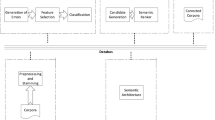Abstract
Multiple algorithms have been developed to correct user’s typing mistakes. However, an optimal solution is hardly identified among them. Moreover, these solutions rarely produce a single answer or share common results, and the answers may change with time and context. These motivated this research to synthesize some distinct word correction algorithms to produce an optimal prediction based on database updates and neural network learning. In this paper, three distinct typing correction algorithms are integrated as a pilot research with key factors such as Time Change, Context Change and User Feedback being considered. Experimental results show that the developed WLR model (i.e., word-list neural network ranking model) achieves the best results in comparison with Levenshtein distance, Metaphone. and Two-Gram prediction algorithms throughout all stages. It achieves 57.50% Ranking First Hitting Rate with samples of category one and a best Ranking First Hitting Rate of 74.69% within category four. Further work is recommended to extend the number of parameters and integrate more algorithms to achieve a higher level of accuracy.





Similar content being viewed by others
Explore related subjects
Discover the latest articles, news and stories from top researchers in related subjects.References
Ouazzane K et al (2008) A hybrid framework towards the solution for people with disability effectively using computer keyboard. In: IADIS international conference intelligent systems and agents, pp 209–212
Metaphone, http://en.wikipedia.org/wiki/Metaphone. Accessed 23 Jan 2009
N-gram, http://en.wikipedia.org/wiki/N-gram. Accessed 18 Jan 2009
PAQ [online], 3 Jan 2008, Wikipedia, Available: http://en.wikipedia.org/wiki/PAQ. Accessed 25 Jan 2008
Haykin S (1999) Neural networks—a comprehensive foundation, 2nd edn. Tom Robbins, New Jersey
Levenshtein algorithm, http://www.levenshtein.net/. Accessed 23 Jan 2009
Cohen WW, Ravikumar P, Fienberg S (2003) A comparison of string distance metrics for name-matching tasks. In: IIWeb 2003, pp 73–78
Jaro–Winkler distance, http://en.wikipedia.org/wiki/Jaro-Winkler Accessed 23 Jan 2009
Li J, Ouazzane K, Kazemian H, Jing Y, Boyd R (2009) Focused time-telay neural network modeling towards typing stream prediction. In: IADIS multi conference on computer science and information systems 2009, Algarve
BackPropagation [online], 10 Jan 2008, Wikipedia, available: http://en.wiki-pedia.org/wiki/Back_propagation. Accessed 20 Jan 2008
Normal Probability Density Function [online], The MathWorks—accelerating the pace of engineering and science, available: http://www.mathworks.com/access/helpdesk/help/toolbox/stats/normpdf.html. Accessed 4 July 2010
Far from the Madding Crowd, http://en.wikipedia.org/wiki/Far_from_the_Madding_Crowd. Accessed 15 Apr 2009
Calgary Corpus, ftp://ftp.cpsc.ucalgary.ca/pub/projects/text.compression.corpus/text.compression.corpus.tar.Z. Accessed 18 Jan 2009
Matt Davis, reading jumbled texts, http://www.mrc-cbu.cam.ac.uk/~mattd/Cmabrigde/. Accessed 26 Jan 2009
Disability Essex, http://www.disabilityessex.org. Accessed 18 Jan 2009
Knowledge Transfer Partnership, http://www.ktponline.org.uk/. Accessed 18 Jan 2009
Author information
Authors and Affiliations
Corresponding author
Rights and permissions
About this article
Cite this article
Li, J., Ouazzane, K., Kazemian, H. et al. A neural network based solution for automatic typing errors correction. Neural Comput & Applic 20, 889–896 (2011). https://doi.org/10.1007/s00521-010-0492-3
Received:
Accepted:
Published:
Issue Date:
DOI: https://doi.org/10.1007/s00521-010-0492-3




